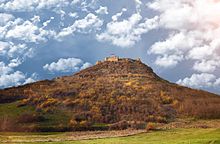|
Serbian nobility conflict (1369)
The Serbian nobility conflict in 1369 was a conflict between two powerful sides of the Serbian nobility, one supporting magnate Nikola Altomanović, and one supporting the Mrnjavčević family in Macedonia and Greece. In 1369, a battle was fought between the two sides at the Kosovo field, ending in the decisive victory of King Vukašin, confirming his supremacy, which would last until 1371 battle of Maritsa.[1] BackgroundEmperor Stefan Uroš IV Dušan was succeeded by his son Stefan Uroš V whose reign was characterized by decline of central power and rise of numerous virtually independent principalities. Stefan Uroš V was not able to sustain the great empire created by his father, or limit the independence of the powerful nobles. Vukašin Mrnjavčević was the most powerful noble in the Serbian Empire, ruling northern Macedonia. Although he was given the title of Despot by Emperor Uroš in 1355, his steady power increase enabled him to crown himself King of Serbs and Greeks in 1365, and extend his claims over west and south Macedonia, Kosovo, and Raška. PreparationsSince the Mrnjavčević family desired to succeed the Nemanjić dynasty as the new rulers of Serbia, Emperor Uroš started supporting a coalition of Serbian elite loyal to him. One of them was Lazar Hrebeljanović, who was married to Princess Milica from the Nemanjić family. Lazar and the Emperor managed to persuade the young but capable general Nikola Altomanović to join their coalition, as well as some minor governors. But, since Nikola was at war with Bosnia, he was only able to bring a portion part of his army, because he had to keep large part of his army on his lands, to protect them from the possible Bosnian attack. Vukašin on the other hand, had the largest and the most powerful army in the Empire - which was also fully professional. BattleThe armies met near Zvečan, in Kosovo. During the battle, the much larger New Nobility, led by the Mrnjavčević dynasty army defeated the Old Nobility, and even managed to capture the Emperor. After seeing that the battle could not be won, Lazar Hrebeljanović retreated from the battlefield with his heavy cavalry. Nikola Altomanovic fought till the very end and was carried off the field heavily wounded by his men. At that time it was even speculated that he did not survive the battle. AftermathThe Mrnjavčević family did not manage to make the most of the battle because of the threat even more serious than the local Serbian rulers - the Ottoman Turks. On September 26, 1371, Vukašin ordered a forced march to Adrianople, but his army was ambushed while camped in the Battle of Maritsa, suffering a heavy defeat that sealed the fate of Serbian Empire, and the chance of a serious counter offensive against the Turks. Both King Vukašin and Jovan Uglješa lost their lives in that battle. Two months later, on 4 December 1371, Uroš, the last Serbian Emperor died at the age of 35. The battle was the place where the hatred between Nikola Altomanovic and Lazar Hrebeljanovic was born. Nikola felt that Lazar had betrayed him, and in the future he would even try to kill him face to face. That would trigger a coalition of Nikola's enemies: Lazar Hrebeljanovic, Tvrtko I of Bosnia, Đurađ I Balšić, Nicholas Garay and the Hungarian King Louis I of Hungary, after which Nikola was blinded and deposed of his holdings. References
Sources
External links
|
||||||||||||||||||||||||||||
